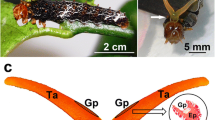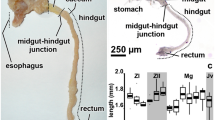Summary
Cells of the hindgut of the European corn borer, Ostrinia nubilalis, have two functions, namely, ion transport and secretion of a hormone called proctodone. In this species, proctodone is an essential requisite to the prepupal molt in conjunction with brain hormone synthesis. Apical infoldings and their associated mitochondria form mitochondrial pumps for ion transport from the gut lumen to the hemocoel. The endocrine function of the cells is evidenced by rhythmical formation and discharge of inclusion bodies every 8 hours. These measure from 800 Å to 3 μ. in diameter and vary in composition from bodies with whorled, myeloid content to inclusions with densely granular matrix. During the discharge phase, granular material appears in the basal infoldings and accumulates in large quantities underneath the basal lamina and in the hemocoelic clefts adjacent to the active cells.
Similar content being viewed by others
References
Bassot, J.-M., et R. Martoja: Présence de faisceaux de microtubules cytoplasmiques dans les cellules du canal éjaculateur de criquet migrateur. J. Micr. 4, 87–90 (1965).
Beck, S. D., and N. Alexander: Proctodone, an insect developmental hormone. Biol. Bull. 126, 185–198 (1964a).
—: Hormonal activation of the insect brain. Science 143, 478–479 (1964b).
—, I. B. Colvin, and D. E. Swinton: Photoperiodic control of a physiological rhythm. Biol. Bull. 128, 177–188 (1965a).
—, J. L. Shane, and I. B. Colvin: Proctodone production in the European corn borer Ostrinia nubilalis. J. Insect Physiol. 11, 297–303 (1965b).
Christensen, A. K.: The fine structure of testicular interstitial cells in guinea pigs. J. Cell Biol. 26, 911–935 (1965).
—, and D. W. Fawcett: The normal fine structure of opossum testicular interstitial cells. J. biophys. biochem. Cytol. 9, 653–670 (1961).
Copeland, E.: A mitochondrial pump in the cells of the anal papillae of mosquito larvae. J. Cell Biol. 23, 253–264 (1964).
Gupta, B. L., and M. J. Berridge: A coat of repeating subunits of the cytoplasmic surface of the plasma membrane in the rectal papillae of the blowfly, Calliphora erythrocephala (Meig.), studied in situ by electron microscopy. J. Cell Biol. 29, 376–382 (1966).
Hassemer, S. M., and S. D. Beck: Histochemistry of the ileum of the European corn borer, Ostrinia nubilalis. J. Insect Physiol. 14, 1233–1246 (1968).
Karlson, P.: On the chemistry and mode of action of insect hormones. Gen. comp. Endocr., Suppl. 1, 1–7 (1962).
Locke, M., and J. V. Collins: The structure and formation of protein granules in the fat body of an insect. J. Cell Biol. 26, 857–884 (1965).
Noirot-Timothée, C., et C. Noirot: Attaches des microtubules sur la membrane cellulaire dans la tube digestif des termites. J. Micr. 5, 715–724 (1966).
Odhiambo, T. R.: The fine structure of the corpus allatum of the sexually mature male of the desert locust. J. Insect Physiol. 12, 819–828 (1966a).
—: Ultrastructure of the development of the corpus allatum in the adult male desert locust. J. Insect Physiol. 12, 995–1002 (1966b).
Röller, N., K. H. Dahm, C. C. Sweely, and B. H. Trost: The structure of the juvenile hormone. Angew. Chem. 6, 179–180 (1967).
Scharrer, B.: Neurosecretion. XIII. The ultrastructure of the corpus cardiacum of the insect Leucophaea maderae. Z. Zellforsch. 60, 761–796 (1963).
—: Histophysiological studies on the corpus allatum of Leucophaea maderae. IV. Ultrastructure during normal activity cycle. Z. Zellforsch. 62, 125–148 (1964a).
—: The fine structure of blattarian prothoracic glands. Z. Zellforsch. 64, 301–326 (1964b).
—: Recent progress in the study of neuroendocrine mechanisms in insects. Arch. Anat. micr. 54, 331–342 (1965).
—: Ultrastructural study of the regressing prothoracic glands of blattarian insects. Z. Zellforsch. 69, 1–21 (1966).
—: Neurosecretion. XIV. Ultrastructural study of sites of release of neurosecretory material in blattarian insects. Z. Zellforsch. 89, 1–16 (1968).
Author information
Authors and Affiliations
Additional information
This study constitutes publication No. 358 from the Oregon Regional Primate Research Center, supported in part by postdoctoral training fellowship 1-T1AM-5521-02 and Grant FR 00163 from the National Institutes of Health.
Rights and permissions
About this article
Cite this article
Alexander, N.J., Fahrenbach, W.H. Fine structure of endocrine hindgut cells of a lepidopteran, Ostrinia nubilalis (Hübn.). Z. Zellforsch. 94, 337–345 (1969). https://doi.org/10.1007/BF00319181
Received:
Issue Date:
DOI: https://doi.org/10.1007/BF00319181




